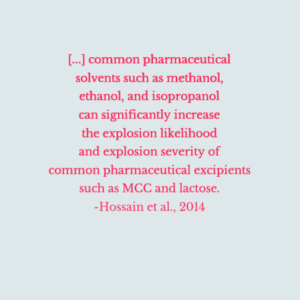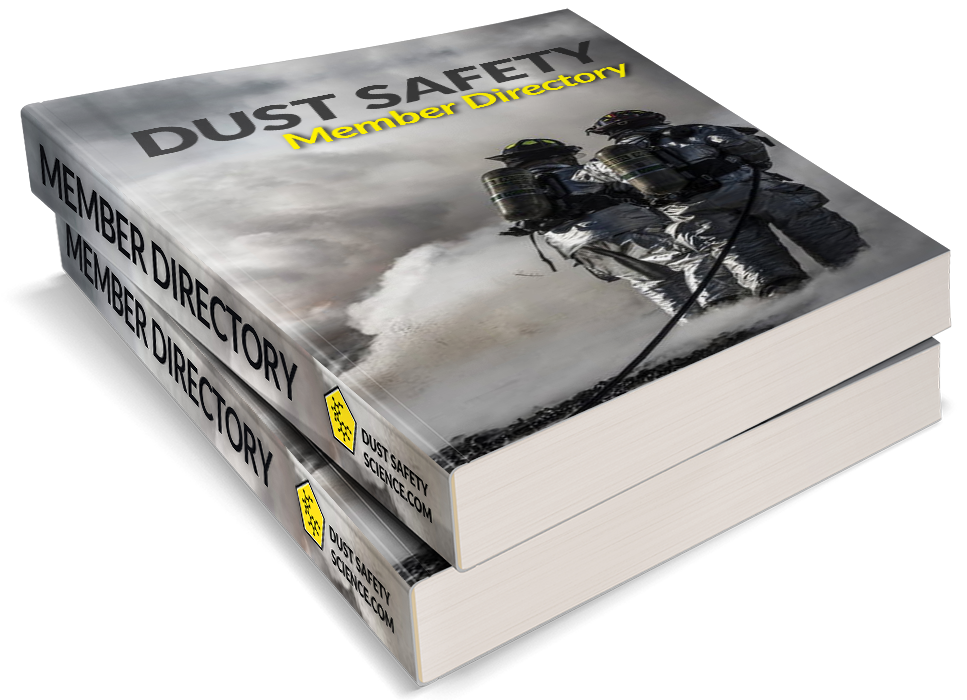Updated August 26, 2024 Authored by Chris Cloney
Hybrid Mixture Explosion
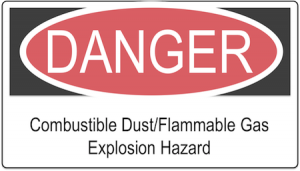
Hybrid mixtures contain both combustible dust and flammable gas. The explosion of hybrid mixtures represents an enhanced industry hazard as both the severity and likelihood can increase from the presence of the second fuel.
This post briefly summarizes 12 journal articles in this research area. Relevant industries, main findings, and points of disagreement are discussed. The final two sections give links to three minute summaries of each article and the full reference information.
The main focus of this post is hybrid explosion parameters determined in closed chambers at a laboratory scale. For the current purposes, explosion severity is indicated by maximum rate of pressure rise and likelihood is indicated by explosibility limits. It is important to note that other parameters such as maximum overpressure, minimum ignition energy, and minimum ignition temperature, and such as changes in dust concentrations that are lower than their lower explosion limit, (LEL) values, may also be important to consider, regarding a dust explosion.
Other posts relevant to hybrid explosion can be found under the Hybrid Explosion and Hybrid Flame Structure keywords. A full listing of posts in other areas relevant to dust and gas explosions can be found on the Blog Keywords or Blog Categories pages.
Industry Coverage
The industries covered in this summary include mining, nuclear, pharmaceutical, and general processing. Explosion of hybrid mixtures in the mining industry is explored by Li et al., 2012 and Ajrash et al., 2016. Both authors focus on adding small amounts of methane gas to explosible coal dust concentrations.
Hybrid mixtures in the nuclear industry are explored by Denkevits, 2007, Denkevits, 2010, Khalil, 2013, and Denkevits and Hoess, 2015. These authors investigate explosion of hydrogen gas with the addition of graphite/carbon, tungsten, and aluminum dusts.
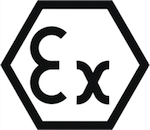
A variety of hybrid mixtures relevant to the pharmaceutical industry are explore by Dufaud et al., 2008, Dufaud et al., 2009, Garcia-Agreda et al., 2011, Sanchirico et al., 2011, and Hossain, 2014. These studies cover the largest breadth of explosion characteristics including severity, explosibility limits, and characterizing the explosion process for hybrid mixtures.
The last paper included in this review is from Pilao et al., 2006. This paper investigates the explosibility of cork dust and methane gas mixtures, and is relevant to the manufacturing of cork stoppers. This work demonstrates the importance of hybrid mixtures in general processing industries.
Summary of Main Findings
The largest finding across all papers is that even small amounts of the second fuel can greatly change the explosion severity and likelihood of the first. In most cases, explosion severity is enhanced significantly, especially at fuel lean concentrations (e.g., see Li 2012, Denkevits 2010, Hossain 2104). Adding combustible dust to a fuel rich flammable gas may cause a reduction in explosion severity Denkevits 2007; However, it is important to keep in mind that dust may also increase the local turbulence leading to increased explosion severity instead (e.g., see Amyotte et al., 1988).
Almost all papers that investigate explosibility limits report explosions for mixtures below the gas lower flammability limit (LFL) and dust minimum explosible concentration (MEC) [Ajrash 2016,Khalil 2013, Dufaud 2009, Garcia-Agreda 2011, Sanchirico 2011, Pilao 2006]. This is important for explosion prevention as the presence of hybrid conditions means that explosions can occur more easily than if only a single fuel is anticipated. The work of Dastidar et al., 2005 presents considerations for hazard analysis of these mixtures in processing plants.
Two competing theories have been proposed for predicting the explosion limits of hybrid mixtures: Le Chatelier’s Law and Bartknecht’s relation. See the derivation by Mashuga and Crowl Mashuga 2000 and the textbook by Bartknecht, 1989 for more information on these two theories, respectively. Further discussion on the experimental findings from the 12 papers summarized here is given in the “Points of Disagreement” Section below.
The work of Garcia-Agreda et al., 2011 attempts to characterize the explosion process for hybrid mixtures. These authors proposed five explosion regimes depending on the amounts of fuel relative to their flammability criteria:
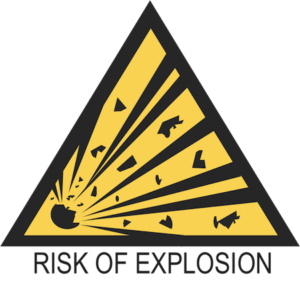
- Dust Driven Explosion – Dust > MEC, Gas < LFL
- Gas Driven Explosion – Dust < MEC, Gas > LFL
- Dual Fuel Explosion – Dust > MEC, Gas > LFL
- Synergistic Explosion – Dust < MEC, Gas < LFL
- No Explosion
This approach is useful for envisioning the combustion phenomena occurring for hybrid mixtures. This work was extended by Sanchirico et al., 2011 to different ignition energy and turbulence levels. The work of Denkevits, 2007, Denkevits, 2010 and Denkevits and Hoess, 2015 also demonstrate the combustion stages for hybrid mixtures and these authors developed the following groupings: gas-only explosion, two-step explosion, single-step explosion, and dust-only explosion.
Points of Disagreement
The first major point of disagreement focuses on the worst-case-scenario for explosion of hybrid mixtures. The results of Garcia-Agreda et al., 2011 and Sanchirico et al., 2011 suggest that the worst-case condition is pure gas near its stoichiometric concentration. These findings are in contrast to several studies [Dufaud 2008, Dufaud 2009,Khalil 2013, Denkevits 2010, Denkevits 2015] which demonstrate “more than additive effects” (term used by Dufaud et al., 2008). In these studies the worst case explosion occurred at different mixtures of dust and gas. The effect of chemical kinetics and dust-turbulence interaction on hybrid explosion severity is not well understood and the worst-case explosion severity question poses real problems for researchers and industry alike.
The second unresolved point of disagreement involves explosion limits of hybrid mixtures. Two competing theories have been presented in the literature. Le Chatelier’s Law treats the solid/gas mixture as a gas/gas mixture and assumes linear mixing between the explosion limits:
\(c = MECleft(1 – frac{y}{LFL}right)\)
where the dust concentration at the flammability limit (\(c\)) can be estimated from the gas concentration (\(y\)). The individual flammability limits MEC and LFL are from the pure fuels alone. As explained by Mashuga and Crowl, Mashuga 2000, this theory assumes that the fuels have similar flame temperature and combustion properties.
The second competing theory is Bartknecht’s quadratic relation which states that explosion limits are wider than predicted using Le Chatelier’s Law. It is generally applied for fuels with low burning velocities (e.g., methane):
\(c = MECleft(1 – frac{y}{LFL}right)^{2}\)
This relation suggests that less dust is required to generate an explosible mixture than predicted using linear mixing at a given gas concentration.
From the 12 articles reviewed significant deviations were found in the conclusions on explosibility limits. Garcia-Agreda et al., 2011 saw agreement between Le Chatelier’s Law and the flammability limits of methane gas and niacin dust mixtures. Dufaud et al., 2009 and Ajrash et al., 2016 found wider explosion limits as predicted using Bartknecht’s relation. However, in contrast to both these theories, several studies (Sanchirico et al., 2011, Pilao et al., 2006, and Khalil et al., 2013), found explosion limits narrower than predicted using either approach. These conflicting results demonstrate a need to better understand and characterize hybrid explosion limits.
Conclusion
This literature summary demonstrated several important points regarding the explosion of hybrid mixtures. Again, it is important to highlight that parameters other than the maximum rate of pressure rise and lower explosibility limits may be important to consider depending on the processing application.
Hybrid mixture explosions, where both combustible dust particles and flammable gases are present, pose unique explosion hazards in various process industries. For example, in coal mines, coal dust mixed with methane gas creates a hazardous hybrid mixture that significantly lowers the explosion limit, increasing the risk of an explosion occurring. The explosion characteristics of hybrid mixtures are more complex than those of a dust explosion or gas explosion alone. In particular, the explosion pressure rise and the maximum explosion pressure tend to be higher, making these explosions more severe. Understanding the parameters of hybrid mixtures in depth is critical for mitigating explosion hazards in industrial settings.
Case studies and experimental data on hybrid mixture explosions provide valuable insights into the explosion regimes and explosion sensitivity of these mixtures. For example, when both the gas and dust cloud are present, the minimum ignition energy required to trigger an explosion is lower than that for either component alone. This means that hybrid mixture explosions can occur under conditions that might not typically lead to an explosion in the presence of just dust or gas. The presence of flammable gases in the dust clouds significantly increases the explosion threat, as evidenced by the higher explosion pressure increase and the challenges in establishing reliable explosion criteria.
The explosion behavior of hybrid mixtures, such as the interaction between dust particles and flammable gas, is influenced by various factors including dust concentration, oxygen concentration, and particle diameter. For example, in coal mines, the combination of coal dust and methane gas can lead to a higher explosion risk due to the lower explosive limit of the mixture. This underscores the importance of explosion testing and the need for reliable explosion criteria to assess the explosion hazards accurately. Understanding the characteristics of hybrid mixtures, such as their explosion parameters and limiting oxygen concentration, is vital for ensuring industrial safety and preventing catastrophic incidents. Further research is needed to explore hybrid mixtures in depth, particularly regarding the explosion parameters and safety characteristics under various conditions. Experimental studies using tools like the 20 L sphere can provide valuable data on the explosion severity and limiting oxygen concentration of these mixtures.
In-depth research and case studies on hybrid mixture explosions highlight the need for comprehensive experimental data and theoretical explanation to fill current research gaps. For instance, experimental measurements of explosion severity parameters, such as the rate of pressure increase and the maximum explosion pressure, are crucial for developing safer industrial process designs. Moreover, slight modifications in initial conditions, such as changes in dust concentrations that are lower than their lower explosion limit, (LEL) values, (even if both the gas and the dust concentration are lower than their lower explosion limit (LEL) values), carbon monoxide concentration, or the presence of flammable gases, can have significant effects on the explosion behavior of a particular hybrid mixture. Future research should continue to focus on gathering more data and refining safety characteristics to enhance environmental protection and reduce explosion hazards such as dust clouds and a simple electric spark, in process industries. Understanding the explosion threat of hybrid mixtures contributes to the safety and sustainability of manufacturing facilities.
The papers summarized in this post give a broad overview of the available literature. This summary is not all-inclusive and several important papers may be absent. For other paper summaries included on this website see the “Three Minute Papers” category or the Blog Keywords page.
Other papers that are of particular interest to explosion limits of hybrid mixtures include Amyotte et al., 1993, Chatrathi, 1994, Landman, 1995, Nifuku et al., 2006, Prugh, 2008, Jiang et al., 2014, Jiang et al., 2015, and Addai et al., 2015. These papers should be reviewed by anyone looking to understand this research area, including the area of a dust explosion.
Lastly, if you have any comments or questions please post them below. No thought is too small and I would love to hear from you! If you would like to connect further or discuss off-line you can reach me from the Contact Me page or at [email protected].
12 Journal Articles for Explosion of Hybrid Mixtures
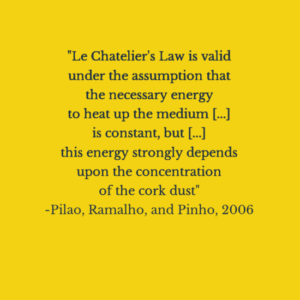 |
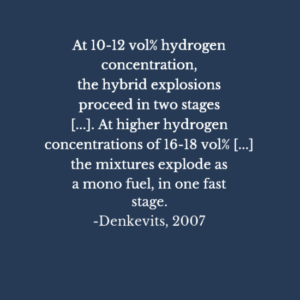 |
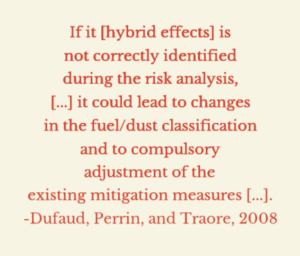 |
|---|---|---|
| Citation: [Pilao 2006] | Citation: [Denkevits 2007] | Citation: [Dufaud 2008] |
| Major Finding: Hybrid flammability limits for cork dust/methane mixtures are narrower than the predictions of Le Chatelier’s Law | Major Finding: At medium gas concentration a two-stage explosion process occurs while at higher gas concentrations a single-stage explosion occurs | Major Finding: Hybrid mixtures can have “more than additive” effects on explosion consequence |
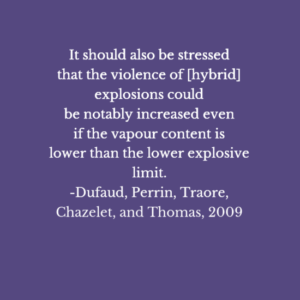 |
 |
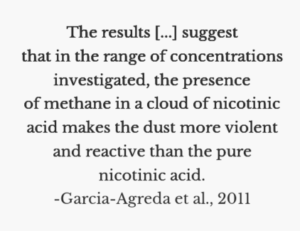 |
|---|---|---|
| Citation: [Dufaud 2009] | Citation: [Denkevits 2010] | Citation: [Garcia-Agreda 2011] |
| Major Finding: Hybrid explosibility limits are wider than predicted by Le Chatelier’s Law | Major Finding: Explosion of hybrid mixtures involving tungsten and hydrogen are more violent then hydrogen alone under fuel lean conditions | Major Finding: Hybrid explosions can be divided into five categories based on the fuel concentration |
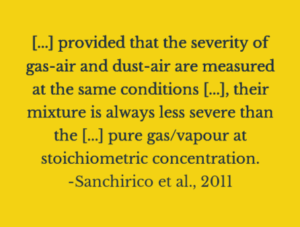 |
 |
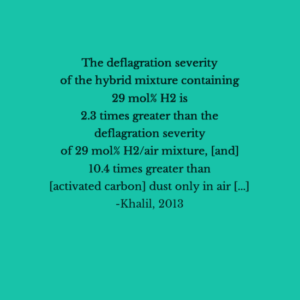 |
|---|---|---|
| Citation: [Sanchirico 2011] | Citation: [Li 2012] | Citation: [Khalil 2013] |
| Major Finding: Explosion severity decreases with dust addition along lines of constant mixed stoichiometric ratio | Major Finding: Explosion likelihood and severity increases with an increase in hydrogen gas content in the coal volatiles | Major Finding: Explosion severity of stoichiometric hydrogen is significantly increased by the presence of activated carbon dust |
|
|
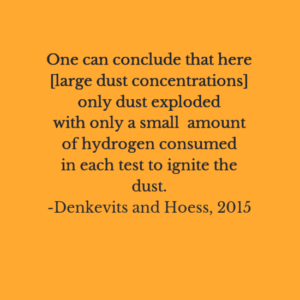 |
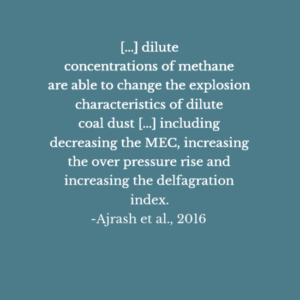 |
|---|---|---|
| Citation: [Hossain 2104] | Citation: [Denkevits 2015] | Citation: [Ajrash 2016] |
| Major Finding: Explosion severity and likelihood increase with addition of solvent to the dust in liquid or vapour form | Major Finding: At high dust concentrations hydrogen gas only acts to ignite the dust but is not involved in the subsequent combustion process | Major Finding: The explosion limits of coal/methane mixtures lie between Le Chatalier’s Law and Bartknecht’s relation |
